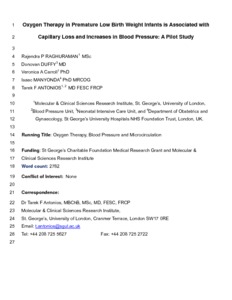Raghuraman, RP; Duffy, D; Carroll, VA; Manyonda, I; Antonios, TFT
(2020)
Oxygen therapy in premature low birth weight infants is associated with capillary loss and increases in blood pressure: a pilot study.
JOURNAL OF HUMAN HYPERTENSION, 34 (4).
pp. 278-285.
ISSN 0950-9240
https://doi.org/10.1038/s41371-019-0211-1
SGUL Authors: Antonios, Tarek Francis Tewfik
![[img]](https://openaccess.sgul.ac.uk/110808/1.hassmallThumbnailVersion/10874_1_merged_1553856288.pdf)  Preview |
|
PDF
Accepted Version
Available under License ["licenses_description_publisher" not defined].
Download (181kB)
| Preview
|
Abstract
Low birth weight (LBW) and premature birth are known risk factors for future cardiovascular disease and in particular essential hypertension (EH). Capillary rarefaction (CR) is an established hallmark of EH and is known to occur in individuals with a history of LBW. We previously reported that LBW infants do not have CR at birth but rather increased capillary density (CD). We hypothesized that LBW infants undergo a process of accelerated CR in early life, triggered in part by oxygen therapy. We studied 26 LBW infants, of whom 10 infants received oxygen therapy, and compared them to 14 normal birth weight (NBW) infants. We measured CD at 1, 5 and 10 days after birth and again after 40 weeks adjusted gestational age equivalent to birth at full term. We confirmed that LBW infants had higher CD at birth compared to NBW infants and found that significant structural CR occurred at term age in LBW infants who had received oxygen therapy (mean difference −22 capillaries/field, p = 0.007) and in those who did not receive oxygen therapy (mean difference −29 capillaries/field, p < 0.001) compared to baseline at birth. Both LBW groups showed a significant rise in BP at 40 weeks adjusted term age and the rise in systolic (mean difference 24 mm Hg, p < 0.0001) and diastolic BP (mean difference 14 mm Hg, p < 0.001) was more pronounced in the oxygen treated group compared to the nonoxygen group (mean difference 14 mm Hg, p = 0.043 and mean difference = 9 mm Hg p = 0.056 respectively). In conclusion, oxygen therapy in premature LBW infants may induce significant increases in their BP in early life.
Statistics
Item downloaded times since 14 May 2019.
Actions (login required)
 |
Edit Item |


